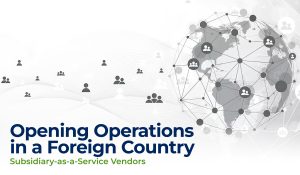Wrapping up a turbulent, unpredictable year for businesses, the December 2020 cover story in Harvard Business Review Magazine explores a timely, yet poignant dilemma for organizations moving forward:Are majority-remote organizations the future of knowledge work, and is work-from-anywhere (WFA) here to stay? This shift emphasizes the increasing importance of IT nearshoring and remote work strategies.

The article shares some impactful early results from the global remote work experiment that has become the day-to-day reality for the business world. Early conclusions suggest that people will prefer a hybrid model blending remote work with in-office, as it keeps the benefits that remote workers have become accustomed to while avoiding the negative impacts that come with extended periods of home-based isolation.
The current situation may change drastically in the next year, as vaccines are rolling out already. However, while humankind looks forward to returning to the status quo, our working lives are likely to change forever. Companies will of course re-introduce pre-pandemic operations, face-to-face meetings, site visits, and staff parties, but the big difference will be how everybody accepts and expects new remote work practices—the way we see it, virtual is here to stay.
While this post-pandemic hybrid model is uncharted territory for most companies, IT nearshoring providers have been operating this way for the last 15 years—in other words, this “new normal” is their status quo.
The IT Nearshoring Advantage Post-Pandemic
For almost two decades, IT companies have been establishing IT nearshoring subsidiaries to tap into cost-effective, well-educated Latin American talent pools. Compared to offshore, the nearshore advantages of geographical proximity and cultural affinity are better suited to a hybrid delivery model, and nearshore customers know it. For example, Mexico is home to a number of business software consulting firms that provide services to their customers in the United States, both remotely and on-site.
Part of what differentiates nearshore teams is that projects are driven by outcomes, not by increased work hours. Consulting teams work on deliverables in stages, meeting deadlines in a pre-defined timeline. Nearshore teams can also travel for key meetings when they’re required to, as many companies are situated a similar distance away as cities in the US—they can even visit on the same day if necessary. As an example, Monterrey in Mexico is only 1 hour and 20 minutes away from Dallas by air.
How IT Nearshoring Might Change in 2021
Customers now are accustomed that most of the delivery will happen remotely, even once free travel opens up again and face-to-face meetings become possible. Alongside the higher focus on virtual delivery, there are a few other changes to expect in 2021.
Digital sales processes evolved in 2020, with requirements gathering, solution demos, proof of concept, and project presentations all happening online. We expect companies in the IT industry to also evolve their sales teams to match this new approach. Some companies in the business applications and technology ecosystem have already started doing this, like SAP Partners.
With digital selling lowering market entry barriers, IT consulting firms can now access new regions & customers. Remote sales have leveled the playing field for midsize companies, offering diversified income from different markets that were too costly to tap into pre-pandemic.

As supply chains reorganize and readjust to the new reality, there may also be a return to using more regional trade blocs like the updated USMCA—formerly known as NAFTA. The treaty gives Canada, the United States, and Mexico IP protection, access to work visas, and other benefits for IT companies. It also includes a full set of labor laws that prevent the misclassification of contractors or the withholding of taxes.
As supply chains reorganize and readjust to the new reality, there may also be a return to using more regional trade blocs like the updated USMCA—formerly known as NAFTA. The treaty gives Canada, the United States, and Mexico IP protection, access to work visas, and other benefits for IT companies. It also includes a full set of labor laws that prevent the misclassification of contractors or the withholding of taxes.
Tapping into the Benefits of Nearshore
As we move into 2021 and the “new normal”, as many people are dubbing it, companies with nearshore operations already have a head start. They have the business processes in place to thrive in this new environment, as well as the ability to replicate them through the rest of the organization and with their partners.
If your company plans to open a nearshore practice this year, we recommend considering the following tips.
- Don’t Forget the Office. Although most work can be delivered remotely, your team will need an office. It serves as an operational address, a company headquarters, a collaborative coworking space, and a place to host meetings, making it vital for developing company culture and identity. Still, there’s a lot of money to be saved with the hybrid approach, so think a bit smaller than that huge warehouse you had your eye on.
- Consider Market Entry Partners. Find a market entry partner that can support the setup of temporary or permanent operations. These companies provide a framework to scale when necessary while using their economies of scale. Some offer business development services for new entrants and have a pre-vetted talent pool for rapid hiring. Check a potential partner’s industry specializations, as it will be critical for shortening your learning curve and costs.
- Focus on Resilience. Use the new capabilities as a catalyst for recovery, but also ensure you have a contingency plan in place to exit new territories if conditions change. Some providers have turn-key capabilities that you can benefit from, while other are more flexible.
It is a new business environment, but there are lessons that can be learned from nearshore companies when implementing new workforce practices and expanding the geographic reach



